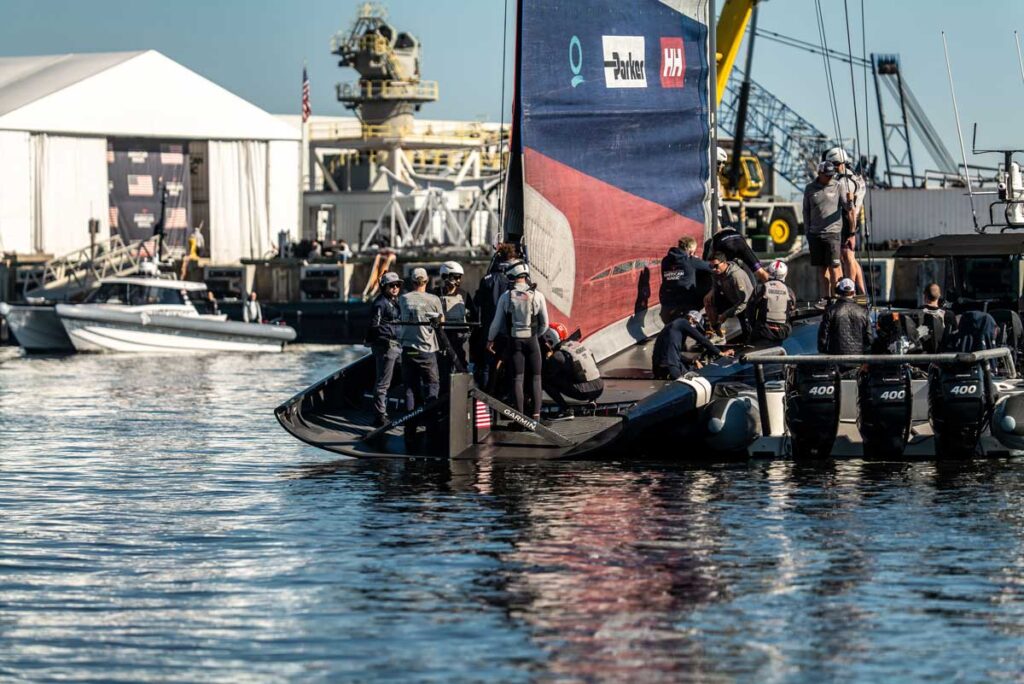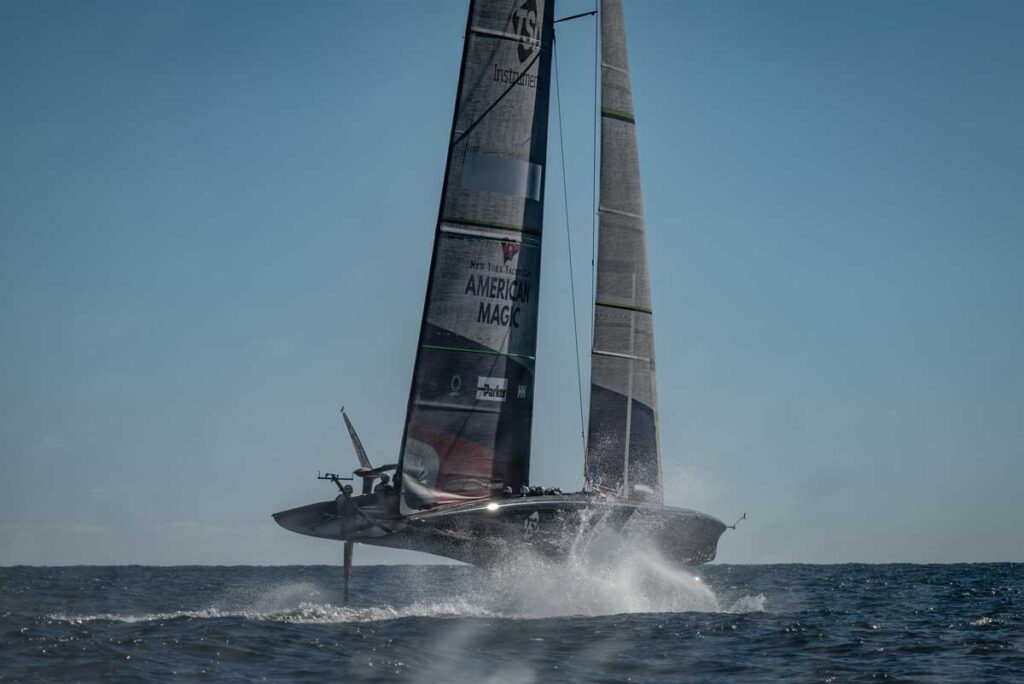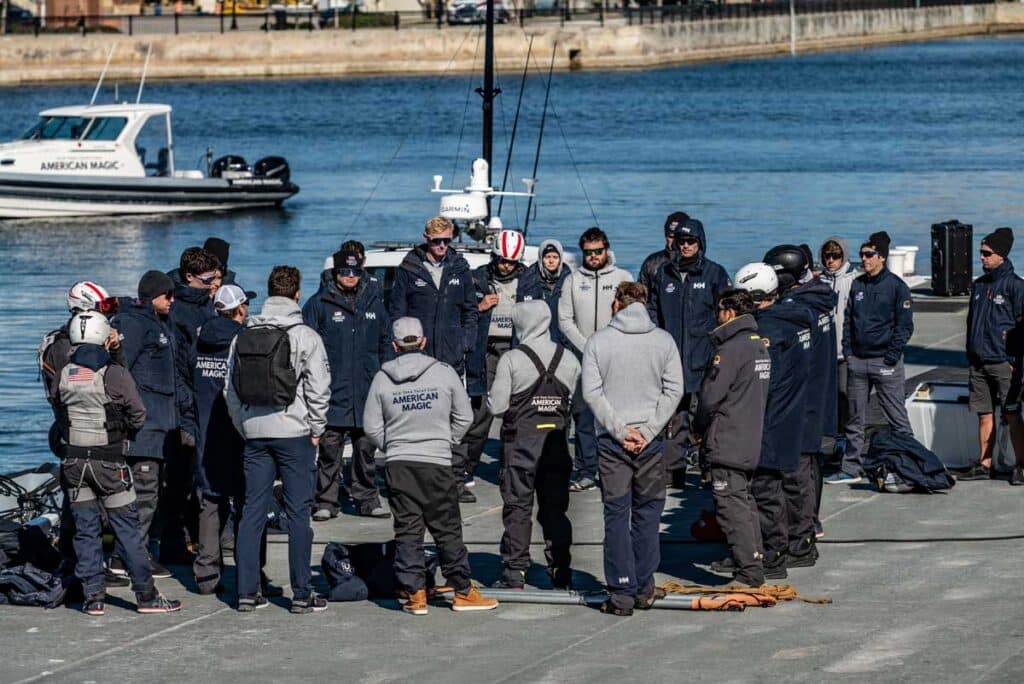
America’s Cup training bases like that of the New York YC’s American Magic, are nothing fancy, but behind the curtained walls and inside modified shipping containers and mobile offices are vibrant centers of innovation, high-level sports training facilities, sophisticated workshops, technological research facilities and boatyards. Here, the work is mostly dirty and determined, yet the mission is clear: win the America’s Cup.
There are, of course, hundreds of moving parts that must be coordinated with a precision that any rank of military brass would appreciate, especially when the entire operation is wrapped, packed and shifted to Barcelona early this summer. Like every America’s Cup team dating back to the first defense in 1870, the goal in Pensacola is to create a fast boat and prepare a skilled crew. The specifics of design technology, construction and tactical gambits are closely guarded secrets because often the smallest innovation can make the difference between victory and defeat. This much was reinforced during a recent visit with American Magic where the attitude of the team and the long to-do lists loomed large. Terry Hutchinson is the team’s skipper and head of the sailing team. He will not be sailing on the boat for this Cup, but is involved of every aspect of the program.
Veteran America’s Cup designer, Scott Ferguson, is overseeing the work of a 30-member design team, which includes, Len Imas, Pete Melvin and Britt Ward, all experienced America’s Cup hands. The design group was able to dive deep into the analytics of Patriot, American Magic’s AC75 which famously crashed and capsized in Auckland. The second-generation AC75 hulls for Barcelona in 2024 will be about 1,000 kilograms lighter and the number of crew is reduced from eleven to eight. Winch grinders are replaced by cyclists who will pedal to make hydraulic power, which is used to trim the sails and operate several foil components. The boat itself is filled with a maze of wires, lines, and hydraulic tubes that spread like veins throughout the boat.
The hull must be strong to withstand heavy loads when sailing at high speeds (over 50 knots at times) and yet light enough for fast takeoff. It is a tricky balance to keep the boat on its foils throughout the entire race, especially given how difficult it is to take off in winds less than 8 knots.

Creating the correct foil package, therefore, is one of the most important tasks of the design team. The loads on the foils are tremendous. Barcelona features choppy waves that will add more strain when foiling. Over the next several months, every team will experiment with up to four different foil designs on their AC40s or prototypes. Each team will be allowed to only race with one foil design. It can’t be changed once the competition starts. There are many design factors to consider: Should the foils be allowed to bend? Longer foils are easier to lift the boat out of the water, but slower once the boat is foiling. There are a variety of endplates to consider, and the flaps that control the “flight” must work easily and reliably. I noticed a smooth carbon fiber skin on the foil blade, there are no creases in the joints, and everything is beautifully engineered. I was told the final foil design package will take about three months to build.
The sailors will be able to choose different headsails and mainsails on race days depending on the wind strength and sea state. The mainsail shape changes dramatically during every maneuver—remember there are two “skins” and each one can be manipulated independently. The mainsail has no boom and is trimmed right down to the deck. The headsail is basically a self-tacking jib. With the apparent wind so far forward there is no need to set a Code Zero or spinnaker. Instead, the crews will have four headsails to choose from on race day. The jib luff is wrapped around the headstay and attached using a zipper, which makes for a clean entry. In the last campaign, I’m told, it took seven weeks to receive a new batten from a commercial supplier. Now, all battens are made in-house using an autoclave and the build window is down to four days.
Spreading the Manpower
Four crew will work from each hull, with no crew shifting sides, as we witnessed in New Zealand during the 2021 match. Tom Slingsby and Paul Goodison are slated to be the helmsmen for American Magic. Both are Olympic gold medalists and veterans of the America’s Cup. Slingsby was the strategist aboard Oracle Team USA during the amazing comeback in 2013. He has been a standout in the SailGP series. They will serve as tactician when they are not steering. This routine worked well for Luna Rossa Prada Pirelli in 2021. The helmsmen steers with a small wheel, which has a series of buttons that control trim. The helmsman has small monitors to see images from the bow and the numbers of a multitude of displays. One crewmember spends time as the flight controller and a fourth crew is the designated trimmer. Four additional crew (two on each side) are strictly cyclists keeping the power flowing. The cyclists do get short rest periods during the race when the power is at full capacity, but the cyclists work with a specific trainer to build their strength and stamina. Olympic Laser sailor and 2006 Intercollegiate Sailor of the Year, Andrew Campbell, is the flight controller. Two Americans, Riley Gibbs and Michael Menninger, have joined the team and are regularly on the water.

The afterguard works closely with the coaching staff. Veteran Cup sailors and coaches Sean Clarkson and Tom Burnham analyze every function of the day. They observe on-the-water testing and practice from a coach boat powered by four 450 hp outboard engines. The high-speed tender can attain a speed of 62 knots and can easily pull the AC75 out of the water to get it on its foils when the wind is light.
All the instruments on the raceboat are replicated on the coach boat. Goodison speaks on a microphone and his voice can be clearly heard by the coaches. There is constant dialog between all parties. The tender operation is impressively efficient. Every action is carefully choreographed so there are no accidents. It is noticeable that everyone is physically fit as they move sails and operate the boat.
Pensacola has proven to be a good venue providing a lot of sailing time—smooth water in the bay and choppier waters out in the Gulf of Mexico help the team test in different wave conditions—but much more is being gleaned in the top-secret simulator. American Magic’s simulator is managed by Anderson Reggio and Brad Gilreath. The steering station replicates the system on the AC75, and here the sailors can spend time racing, practicing maneuvers, working on boatspeed elements, sailing in every conceivable weather condition, practicing starts, watching the screens, instruments, and the wind on the water. Simulators are used effectively by astronauts, aircraft pilots, ship captains, and race car drivers and now these sailors.
I was given the opportunity to spend about 30 minutes in the simulator and worked up a good sweat in the process. It was also great fun and remarkably close to feeling as if I was on the water.
As of this writing every team will be experimenting and training with their AC40 yachts, including American Magic which took possession of theirs after an industrious winter training block concluded in February with Patriot. The lessons learned and information gleaned will be scaled up for the larger seventy five-foot yachts when they are launched late this year. It is difficult to forecast which team will prevail in 2024, but American Magic looks like a stronger team than we watched in 2021.









